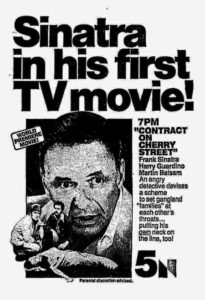In a candid interview conducted by the New York Times in the early 1990s, noted Italian singer Jimmy Roselli, while being asked about his tumultuous relationship with Frank Sinatra, heaped a generous amount of unexpected praise. In telling the interviewer of his belief that Sinatra had developed over the years into a great singer, he went onto say that he believed that Sinatra was a great actor as well, perhaps a better actor then he was a singer. Indeed, Sinatra’s career on film was highlighted by several breakthrough roles, including parts in From Here To Eternity, The Man With The Golden Arm, Ocean’s Eleven, High Society, The Manchurian Candidate, and Von Ryan’s Express, all featuring masterful acting performances from the Chairman of the Board.
As the late 1960s approached, Sinatra would take on a new role, one that many an aging actor (i.e. Richard Widmark, Robert Mitchum, Burt Lancaster, Charlton Heston) from his generation would try out at least once: a detective. This was in the years before the rise of the “buddy cop” film that would dominate the film industry throughout the 1980s and 1990s, and unlike those films, the motion pictures made involving police work in the 1960s and 1970s would focus more on the serious rather than comedic elements of the occupation. Frank would make three of these films (some would say five, although the dramedy films “Tony Rome” and its sequel “Lady in Cement” would center around a private detective) during the course of his career, each time playing a different grizzled veteran cop, the first considered one of the grittiest films of his career.
The Detective (1968)
Based on the novel by Roderick Thorp, “The Detective” centers on the life of Sergeant Joe Leland, a long-time officer with the New York City Police Department, and the trial and tribulations of his upside-down life. Beginning with the murder investigation of the homosexual son of a prominent city official, the film follows Leland as he tries to balance corruption in his precinct, the horrific revelation of his wife as a confessed nymphomaniac and the flashbacks that led them to their current state of separation, as well as the slight romantic overtones of a widow who looks to Leland to solve the mystery behind her late husband’s suicide. Filmed on location in Manhattan, the film indeed provides a gritty, no holds barred look at the somewhat shattered life of a tragic hero. Co-starring the beautiful Lee Remick as Mrs. Leland and also featuring strong supporting roles by Jack Klugman, Ralph Meeker, Tony Musante, Jacqueline Bisset, and a pre-Godfather Robert Duvall, “The Detective” received strong notices at the time of its release (particularly by a young Roger Ebert) and is today considered one of Sinatra’s strongest performances. Sexual overtones are a strong theme throughout the film, and while considered tame by today’s standards, were quite the taboo talk at the time of the film’s opening. Sinatra’s third wife, the young actress Mia Farrow, was scheduled to play Leland’s wife Karen in the film, but filming on her then current film “Rosemary’s Baby” was overextended at the last minute. Feeling snubbed by his bride and consistently the bearer of a rapid-fire temper, Sinatra served Farrow with divorce papers, and Remick stepped in as substitute. Released in theaters by 20th Century Fox in May 1968, the film recouped its $4 million budget by more than half. A strong seller in home rentals for years to come, the film was recently released for the first time on Blu-Ray disc.
Contract On Cherry Street (1977)
Although Sinatra would make a few more films (namely “Lady in Cement” in 1968 and the forgettable nadir of the western “Dirty Dingus Magee” in 1970) before his semi-retirement in 1971, his next significant film work wouldn’t come until nearly the end of the decade, and ironically enough, had Sinatra returning to television with a film production for the first time in more than twenty years with “Contract on Cherry Street.” Sinatra’s mother Dolly, had been an ardent fan of the source novel written by Philip Rosenberg in 1975, and it was perhaps Dolly’s tragic death in a plane crash in January of 1977 that inspired Sinatra to produce (with his company Artanis in conjunction with Columbia Pictures Television) and star in a film adaptation. Prepped for premiere by the National Broadcasting Company, a large ad campaign heralded Sinatra’s first (and only) starring appearance in a television movie. The film pits Sinatra, in the role of Detective Lieutenant Frank Hovannes, against the New York Mafia, waging an unorthodox vendetta against gangsters following the death of his partner (Martin Balsam) along with a crack team of police officers in the Organized Crime Bureau. Filmed extensively on location in both Manhattan and Queens throughout June and July of 1977, including such famous New York locales like Studio 54, the production also features Harry Guardino, Verna Bloom, Jay Black, Henry Silva, and a young Robert Davi (the noted character actor who in addition to a fine resume, also tours today with a Sinatra tribute act). Broadcast over two nights in November of that year to fine ratings, Sinatra received warm notices for his second police outing, notably from renowned movie reviewer Leonard Maltin, in one of his less critical moments. The Edgar Allan Poe Awards, presented to the fields of books, film, and television each year by the Mystery Writers of America, would later honor the production with a nomination for Best TV Picture/Miniseries of 1977.
The First Deadly Sin (1980)
Sinatra’s pivotal, underrated role as Sergeant Edward X. Delaney would be the center of perhaps one of the most off-beat police films of the genre, adapted from the first in a series of “Deadly Sin” detective novels written by author Lawrence Sanders. Focusing more on the human response to an impossible situation, rather than the dramatics of slam bang action, the film finds Sinatra well cast as a veteran New York detective nearly at the eve of his retirement, shuffling between the mystery of a serial string of murders and the imminent death of his bedridden wife (Faye Dunaway). Disgusted with the senseless violence exhibited by the killer, and inspired by the weary words of one of the victim’s widows (Brenda Vaccaro), Delaney sets out to capture the perpetrator, and soon finds himself unsupported by his superiors and at the forefront of a lone wolf manhunt. At the same time, the worsening of his wife’s illness and the seeming carelessness of her doctors to alleviate her condition sends Delaney to the edge as he inches ever closer to the identity of his criminal prey. Featuring strong supporting performances by David Dukes, George Coe (the doctor), Anthony Zerbe (the superior), Martin Gabel (as a wise museum curator), and familiar face James Whitmore (as a gruff coroner long before his days at Shawshank prison), the film was released in October 1980, premiered at Loews’ Theatre in New York as part of a lavish benefit staged by Sinatra for Mother Cabrini Medical Center.
Gordon Jenkins, arranger and longtime musical collaborator with Sinatra, provided the score. With the exception of a few cameo roles and a well-received guest star appearance on the popular “Magnum, P.I.” television program in 1987, “Deadly Sin” serves as Sinatra’s final starring role, an exemplary swan song to an on-camera career that spanned nearly forty years.
In an interesting connection between Sinatra’s detective roles, “The First Deadly Sin” features one of the first appearances of actor Bruce Willis, glimpsed passing Sinatra as he enters a café restaurant Sinatra is using to stalk the suspected killer.
In 1979, Roderick Thorp wrote a novel entitled “Nothing Lasts Forever,” depicting the Joe Leland character from “The Detective” visiting his daughter in California, where she works as an executive for the Klaxon Oil Corporation, the offices housed in a massive Los Angeles skyscraper. Visiting her during the Christmas Eve office party, the aging Leland finds soon finds himself defending her and her fellow workers, going toe to toe against a group of villains as a group of German terrorists raid the building.
The novel was eventually developed into a film script, offered to and passed on by Sinatra at first. Going through several further rewrites, including a name and background change for the Leland character, the script was finally brought before the cameras in 1988 under the title “Die Hard,” with Bruce Willis in the “Leland” role, now renamed John McClane. The film, a smash at the box office, would catapult Willis to wild success as a major action film star. Willis would later recount his brief time spent with Sinatra on the set of “Deadly Sin” during an interview filmed and shown during Sinatra’s 75th Birthday Celebration Special which aired on CBS in December 1990.
Three films, with deep plots and powerhouse casts set against the evolving backdrop of the Big Apple. In the center, Sinatra as a tough cop, taking down the bad guys.
Recommended viewing. Enough said.
Until next time, Sinatra lovers!
Jerry Pearce is an amateur singer in the vein of Frank Sinatra, Perry Como, and Dick Haymes and has released two discs of standards music, Crossroads in 2010, and One Summer Night in 2016. Samples of his music can be heard on his YouTube Channel. To purchase his CDs use the form box below.
[si-contact-form form=’3′]

 July 12th, 2016
July 12th, 2016  CEO
CEO 
 Posted in
Posted in  Tags:
Tags: 



